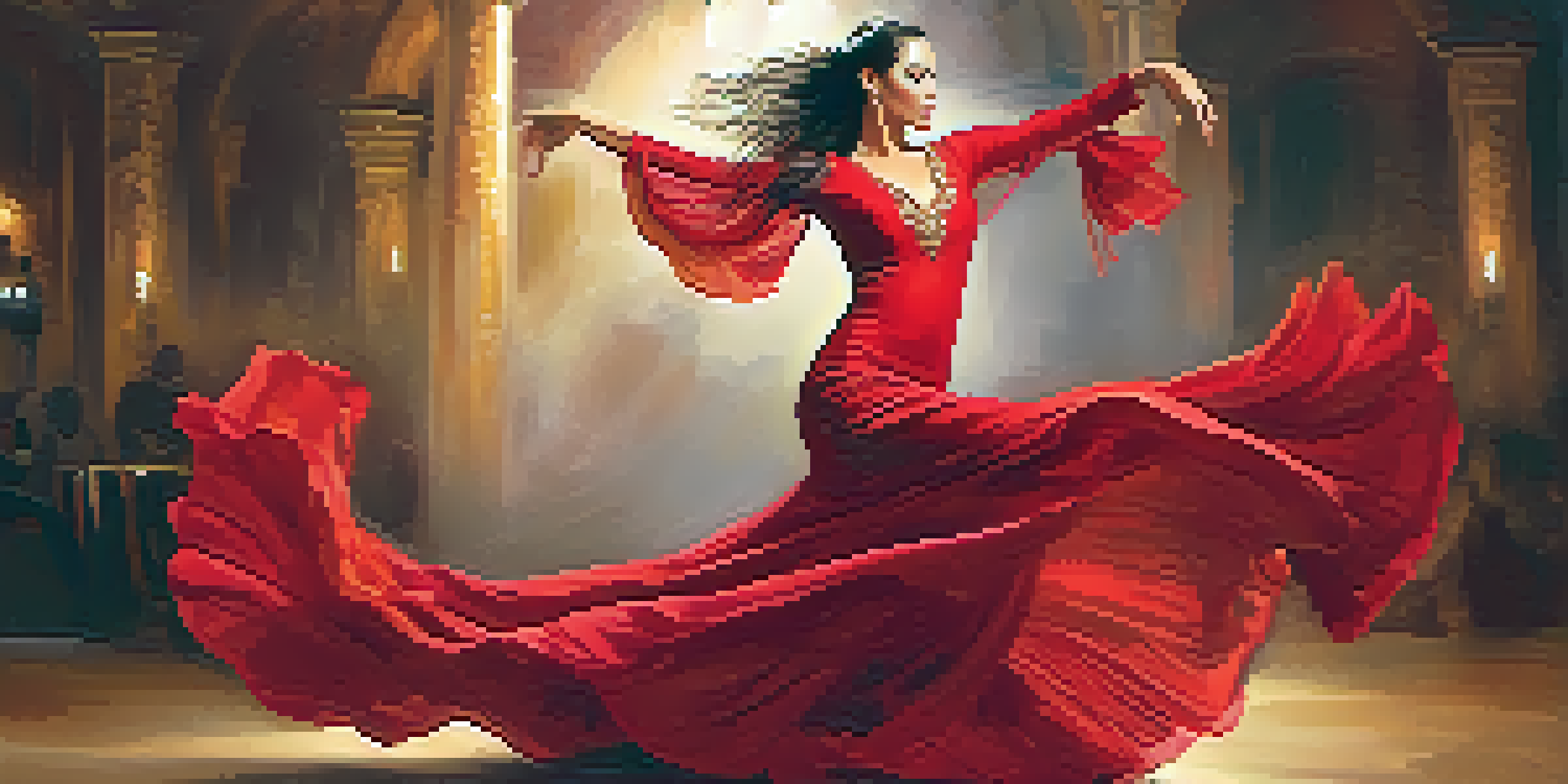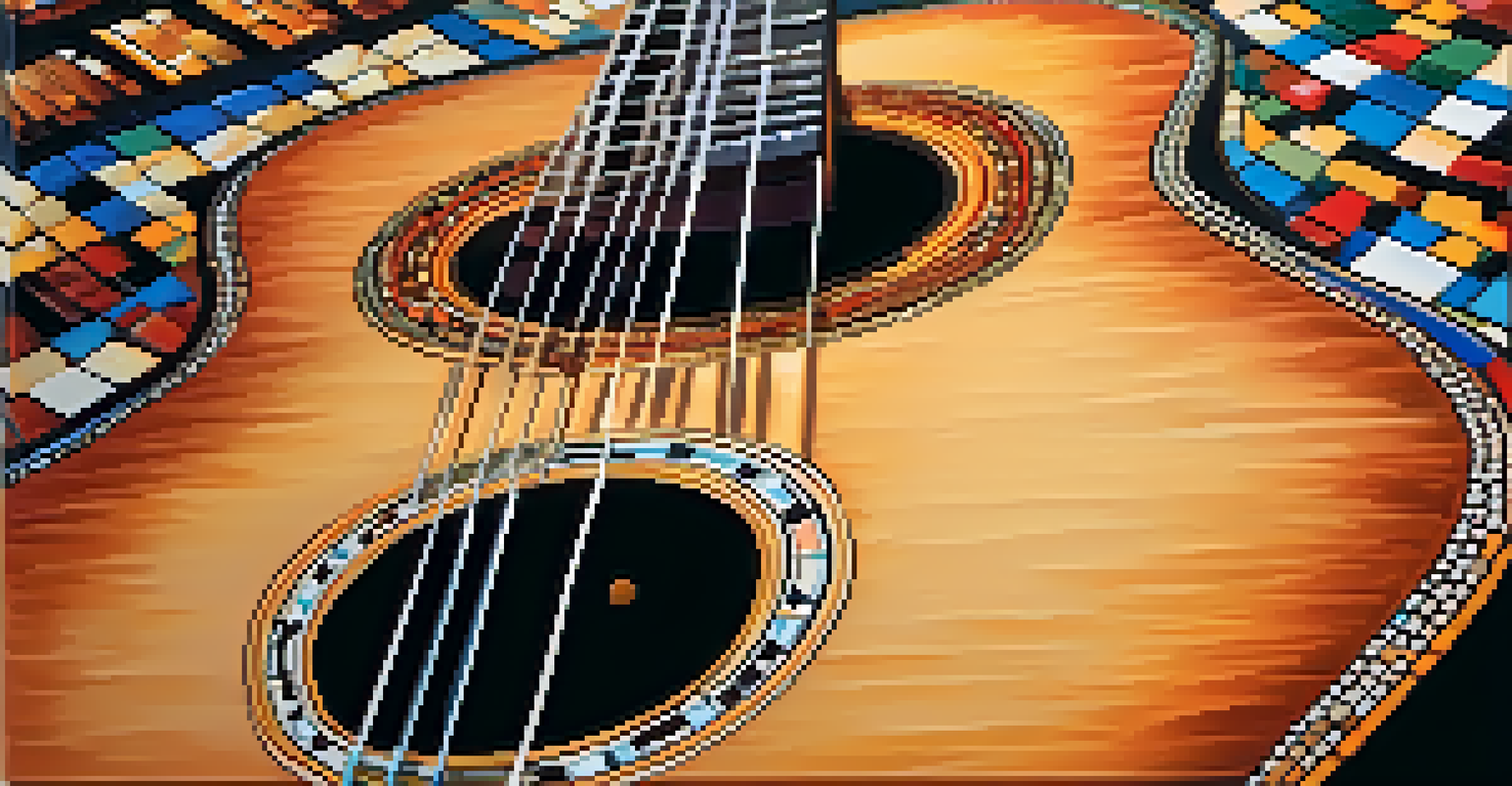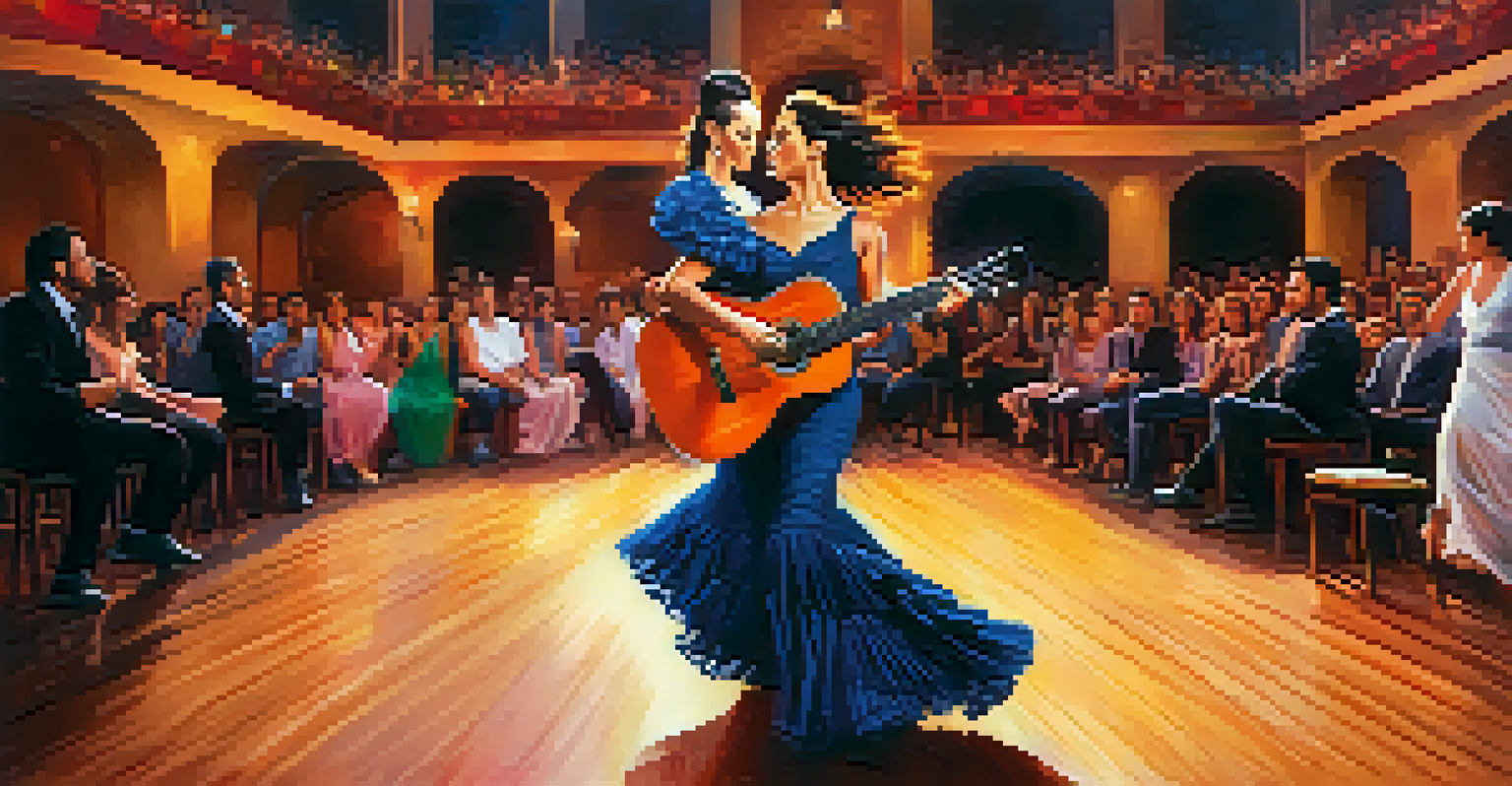Exploring Flamenco: The Cultural Roots of Spanish Guitar Styles

What is Flamenco? Understanding its Essence
Flamenco is more than just a music genre; it's a passionate expression of Spanish culture, particularly from the Andalusian region. This art form combines singing, dancing, and guitar playing, creating a rich tapestry of emotions and stories. The heart of Flamenco lies in its ability to convey deep feelings, often reflecting themes of love, struggle, and joy.
Flamenco is a dance of life, where the emotion of the dancer is reflected in the music of the guitar.
At its core, Flamenco is rooted in the Romani, Moorish, and Jewish influences that have shaped Spain's history. Each performance tells a unique story, often improvised and deeply personal, showcasing the artist's skill and emotional depth. The guitar, a key component of Flamenco, serves as both an accompaniment and a solo instrument, embodying the spirit of the dance and song.
Through its intricate rhythms and melodic lines, Flamenco captures the soul of its performers and the culture from which it originates. The genre has evolved over centuries, absorbing various influences while remaining true to its essence. Understanding Flamenco is to appreciate a vibrant, living tradition that continues to inspire artists worldwide.
The Guitar’s Role in Flamenco: More Than Accompaniment
In Flamenco, the guitar is not just an instrument; it is a storyteller. The nuances of the guitar, from its strumming patterns to intricate fingerpicking, create an emotional landscape that enhances the narrative of the song and dance. This interplay between the guitar and the other elements of Flamenco is what makes it so captivating.

Flamenco guitar playing involves various techniques, including 'rasgueado' (a rapid strumming technique) and 'alzapúa' (a thumb technique that creates a rhythmic pulse). These techniques add texture and depth to the music, allowing the guitarist to express a wide range of emotions. The guitarists often draw on traditional pieces while infusing their unique style, making each performance distinct.
Flamenco: A Cultural Expression
Flamenco is a passionate art form that combines singing, dancing, and guitar, reflecting deep emotions rooted in Spanish culture.
As the backbone of Flamenco, the guitar allows for a dynamic interaction between the musicians and dancers. The improvisational nature of Flamenco means that every performance is a unique collaboration, where the guitar can respond to the dancer's movements and the singer's emotions, creating a captivating experience for the audience.
Key Styles of Flamenco Guitar: A Quick Overview
Flamenco guitar encompasses several distinct styles, each with its own characteristics and emotional resonance. Among these, 'Soleá' is known for its deep, melancholic feel, while 'Alegrías' brings a lively and joyful rhythm. Each style has its own unique patterns and techniques, offering a rich palette for guitarists to explore.
The guitar is the heart of Flamenco; it breathes life into the stories and emotions of the performers.
Another important style is 'Bulería,' which is often characterized by its fast tempo and complex rhythms. This style encourages improvisation and showcases the virtuosity of the guitarist. Each of these styles not only reflects different emotional tones but also represents the diverse cultural influences that have shaped Flamenco over the years.
Understanding these styles can enhance one's appreciation for Flamenco music. Whether it's the soulful strumming of a Soleá or the vibrant energy of a Bulería, each style tells its own story, inviting listeners to experience the depth and richness of Spanish guitar traditions.
The Historical Journey of Flamenco Guitar
The origins of Flamenco can be traced back to the 18th century, but it truly began to flourish in the 19th century, especially in Andalusia. During this period, the guitar became increasingly prominent, evolving from a simple accompaniment to a solo instrument of great complexity. The cultural melting pot of Spain during this time contributed to the richness of Flamenco's sound.
As Flamenco gained popularity, it began to attract artists from various backgrounds, each adding their unique flair to the genre. This period saw the emergence of legendary guitarists who would shape the future of Flamenco. Their innovations and techniques laid the groundwork for contemporary Flamenco guitar playing, ensuring its continued relevance.
Guitar's Central Role in Flamenco
In Flamenco, the guitar serves as a storyteller, enhancing the emotional narrative through intricate techniques and improvisation.
In the 20th century, Flamenco experienced a renaissance, with the guitar taking center stage in both traditional and modern interpretations. This evolution reflects a broader cultural appreciation for Flamenco, showcasing its significance not only in Spain but also on the global stage. Today, Flamenco continues to inspire and evolve, drawing new audiences into its vibrant world.
Famous Flamenco Guitarists Who Shaped the Genre
Throughout the history of Flamenco, many guitarists have left an indelible mark on the genre. One of the most iconic figures is Paco de Lucía, whose innovative techniques and passionate playing elevated Flamenco guitar to new heights. His ability to blend traditional Flamenco with other genres, such as jazz, expanded the horizons of the music.
Another influential guitarist is Vicente Amigo, known for his lyrical playing style and technical prowess. Amigo's work has not only captured the essence of Flamenco but also introduced it to a broader audience. His collaborations with artists from various genres demonstrate the versatility of Flamenco guitar.
These guitarists, among others, have inspired countless musicians, ensuring the legacy of Flamenco guitar continues to thrive. Their contributions have helped shape the sound of Flamenco today, proving that this rich tradition is alive and well, constantly evolving while holding onto its roots.
Modern Influences: Flamenco in Today’s Music Scene
In recent years, Flamenco has seen a resurgence, blending with various musical styles and genres. Artists like Rosalía have successfully fused Flamenco with pop and urban music, introducing this traditional art form to a new generation. This fusion not only keeps the spirit of Flamenco alive but also showcases its adaptability and relevance in contemporary music.
Moreover, collaborations between Flamenco musicians and artists from different genres are becoming increasingly common. This cross-pollination enriches both Flamenco and the collaborating genres, creating a unique sound that resonates with diverse audiences. It's a testament to the enduring allure and versatility of Flamenco.
Modern Adaptations of Flamenco
Flamenco is evolving today, blending with contemporary genres and reaching new audiences through technology and innovative collaborations.
The influence of technology has also played a role in the evolution of Flamenco. With the rise of social media and streaming platforms, musicians can share their work with a global audience, allowing Flamenco to reach fans far beyond Spain. This accessibility ensures that the traditions of Flamenco will continue to inspire new artists for years to come.
Experiencing Flamenco: Where to Enjoy the Art Form
To truly appreciate Flamenco, attending a live performance is essential. Whether in a traditional tablao (a venue dedicated to Flamenco) or at a festival, experiencing the energy and passion of a live performance is unmatched. These events often feature an array of artists, showcasing the rich tapestry of Flamenco talent.
Many cities in Spain, especially in Andalusia, offer opportunities to experience authentic Flamenco. Cities like Seville and Granada are known for their vibrant Flamenco scenes, where you can find both traditional shows and modern interpretations. Engaging with local communities can also provide insights into the cultural significance of Flamenco.

Additionally, online platforms now offer virtual Flamenco performances, making it easier for people worldwide to connect with this beautiful art form. Whether you choose to experience it live or online, immersing yourself in Flamenco will deepen your understanding of its cultural roots and vibrant expressions.